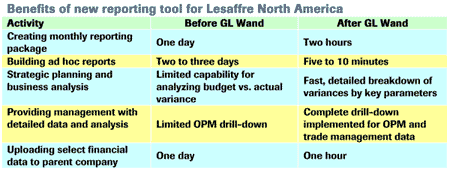
Under the terms of the transaction, Nalco shareholders will have the option to receive either 0.7005 shares of Ecolab common stock or $38.80 per Nalco share in cash. In aggregate, Ecolab will issue approximately 68.9 million shares of Ecolab stock and pay approximately $1.6 billion in cash to Nalco shareholders. This represents a fully diluted offer value of $5.4 billion for Nalco’s equity and, inclusive of $2.7 billion in Nalco net debt, a total transaction value of $8.1 billion. The transaction is expected to close in the fourth quarter.
Based in
“This merger is a strong and vital step in broadening our business platform and enhancing our global growth opportunities,” says Douglas M. Baker, Jr., Ecolab’s chairman, president and chief executive officer. “The key to Ecolab’s long record of consistent and above-average growth has been our ability to continually expand the markets we serve, meet the needs of the customers within these markets and execute.”
“This is a compelling strategic transaction that delivers an immediate premium to our shareholders and the opportunity to participate in the significant upside potential of the combined organization,” says Erik Fyrwald, Nalco’s chairman, president and chief executive officer. “We have long admired Ecolab, and we share similar cultures and business models. We look forward to working together to realize the benefits for all of our stakeholders, including our shareholders, customers and employees.”
Production/processing equipment supports FSMA
To help food manufacturers adhere to new FSMA regulations-and bolster consumer confidence in the safety of their packaged foods-packaging and processing machinery manufacturers are offering multiple solutions for combating challenges before, during and after products run on the line, says Egan.
“Brand integrity starts with spotless, sterile equipment. Before a single food item touches a processing or packaging assembly line, a fast, simple and effective cleaning process should be in place, so more and more makers of processing and packaging machinery are building equipment that requires less time and effort to clean,” adds Egan.
Simplifying the process helps ensure equipment is sanitized correctly and efficiently every time, all while minimizing downtime and maintaining optimal productivity levels. For equipment that is not self-cleaning, this is generally done by building machines with fewer parts that are lightweight and easy for workers to break down and reassemble.
Many food safety initiatives focus on what contaminants could be introduced to the production line. At this stage, it is critical for manufacturers to have effective vision systems or other sensory detection equipment to weed out potentially defective products, according to Egan.
The adoption of multi-camera systems is increasingly providing fast, accurate inspection and traceability while preventing the mislabeling of products on the packaging line. These systems ensure the necessary images are captured without slowing production.
“Another standard screening technique assesses the microbial safety of food, including the Aerobic Plate Count (APC), also known as Total Viable Count or Total Plate Count. Using advanced sensor probes, various inspection technologies can detect oxygen depletion caused by aerobic bacteria more quickly than ever before,” says Egan. “This helps to reduce the testing time and labor needed to determine aerobic bacterial counts in meat, poultry, seafood, dairy and produce.”
Keeping food safe after it leaves the plant is just as important as ensuring its safety on the line. Tamper-evident technologies are essential for protecting the
Without some type of tamper-evident method, the product can easily be compromised either in transit or on the store shelf. Food manufacturers that want to employ additional safety methods on packaging can look to the pharmaceutical industry for inspiration. When faced with FDA mandates to improve package tamper evidence, over-the-counter (OTC) pharmaceutical manufacturers adopted induction cap sealing. Through the last 30 years, induction cap sealing has become a go-to technology for this industry, and its success is poised to translate to the food and beverage sector, says Egan.
Processors and packagers can find these and other innovations to support their food safety efforts at PACK EXPO Las Vegas 2011 (Sept. 26-28,

FDA shouldn't pick on small farms
The Weston A. Price Foundation, a consumer nutrition organization, is urging FDA to focus its resources on large, industrialized food suppliers that pose the highest risk of injury to American consumers.The FDA is holding public meetings and inviting comments on the implementation of the Food Safety Modernization Act (FSMA), which gave the agency broad, new powers to regulate the food supply.
“We were very pleased that the FSMA included the Tester amendment, exempting small-scale direct marketing producers from some of the most burdensome provisions of the new law,” says Sally Fallon Morell, founder and president of the Weston A. Price Foundation (WAPF). “The big question, however, is whether the FDA will respect Congress’ recognition that small-scale, local producers are different from the large-scale, national and multinational companies, which not only produce the majority of our food supply, but have produced almost all of the major foodborne illness problems.”
The FDA faces significant budgetary constraints in implementing the FSMA, as the House version of the FY 2012 Agriculture Appropriations bill cut the agency’s funding by $285 million.
“The agency is complaining that it doesn’t have enough funds to properly address food safety,” continues Morell. “But we’ve seen numerous examples of the agency wasting taxpayer dollars in going after small, local producers. If the agency shifts its focus to the truly high-risk facilities, then it could do a much better job protecting American consumers, even with the reduced funding.”
The comments submitted jointly by WAPF and the Farm and Ranch Freedom Alliance (FARFA) urged FDA to consider several factors in determining which food facilities should be considered high-risk priorities, including the size of the facility, the complexity and scope of the supply and distribution chain, and whether the facility is already inspected at the state or local level. “In essence, the fewer ‘hands’ (including automated hands) that a food passes through, the lower risk it poses,” state the two groups in their comments.
The comments are posted at Regulations.gov and the Weston Price website.Automation News

ERP system gets help from flexible reporting tool
Lesaffre Yeast Corporation and Red Star Yeast Company LLC, a joint venture between Lesaffre Yeast Corporation and Archer Daniels Midland Company Inc., is a producer of yeast for a variety of applications throughout
In 2004, Lesaffre installed the Process Manufacturing version of Oracle E-Business Suite (OPM), designed specifically for recipe-based manufacturing. It was one of the first subsidiaries within the Lesaffre Group family, a global company of 6,000 employees based in
According to Michael Roach, controller for Lesaffre Yeast Corporation, implementation of the system provided immediate benefits, including improved coordination across functional departments and increased efficiencies in doing business. However, soon after installation of the system, Lesaffre’s finance and accounting group discovered challenges in working with Oracle’s Financial Statement Generator (FSG).
After a period of using FSG reports (FSGs), Roach and his team began searching for a tool that could expedite financial reporting while providing better access to detailed OPM data. “The Oracle system provided a backbone of data that was not previously available, but the key was being able to efficiently access, manipulate and analyze this data to help drive the business forward,” says Roach.
“To modify a report, you accessed a separate template and used a type of code to enter the necessary account numbers, decimals places, etc.,” says Jordan Lueck, senior accountant. “Then, you ran the report from Oracle, which took over an hour, only to often find out it didn’t work, requiring a repeat of the process. It took a whole day to run our monthly 100-page package.”
In 2008, the Oracle reporting challenges prompted Lesaffre to explore a new solution. The search led to a one-hour demonstration of GL Wand from Excel4apps, an Excel-based reporting tool that links directly with live Oracle data. Roach was convinced it was the right solution and decided on a one-month trial.
“After just two or three hours of GL Wand training, our finance and accounting users could build reports and drill right into live Oracle data via the Excel front end,” Roach describes. “It was so easy compared with FSGs, and without the time required for coding.”
In May 2008, Lesaffre installed GL Wand, but there was a snag: GL Wand did not yet have drill-down capabilities for OPM, a less common version of Oracle. Working together, the two companies put the functionality in place, plus additional capabilities.
“Within a few months, GL Wand had all the drill-down capability we needed,” Roach explains. “In addition, Excel4apps implemented drill-down for Oracle Trade Management on the accounts receivable side, which basic Oracle didn’t have.”
After converting all existing FSG reports to GL Wand, Lesaffre’s finance group saw major improvements in reporting efficiency (see table).
“It used to take an entire day to run our monthly report package, but with GL Wand it takes about two hours,” says Lueck. “I simply modify the report set by changing dates, file names, etc. Each report takes just 15 minutes.”
Lueck also appreciates the ease of the Excel front end, which allows her to email the reports, whereas using ADI required printing and scanning. “The person requesting the report can modify it as necessary in Excel, which was impossible with the scans,” she says.
While GL Wand met Lesaffre’s goal for a more efficient reporting process, the software’s biggest impact has been in improved support of business analytics and management requests. “We get a number of requests for information from management on a daily basis, and our channel managers are asking for more detailed, customized reports to help them stay on budget,” states Lueck. “With GL Wand, it’s easy to modify an existing report to give them the detail they want in 10 minutes, whereas with the old FSG report writer, it took days.”
For more information about GL Wand, visit Excel4apps.

Poultry producer changes out chlorine in washer
The poultry processor invited Radial Waters to make a presentation, according to Chubby Chick Factory Manager Desmond (Des) du Preez. The producer considered and then committed to a pilot plant at its main location, which would enable the use of both components of Radical Waters’ electro-chemical activation (ECA) process: the Anolyte as a disinfectant and the detergent Catholyte for cleaning. These two solutions are used extensively in several different applications ranging from disinfection to cleaning in both an economical and an environmentally friendly manner.
The pilot exercise proved successful, and Anolyte has subsequently been successfully used at Chubby Chick for several years as a disinfectant. “Anolyte is used at a 30 percent concentration as a final rinse on portions prior to packing for several customers in order to lower microbial loads and extend shelf life,” says du Preez.
On the benefits of Anolyte, du Preez says, “It has the advantage of not having any organoleptic or other detrimental effects on our products and is user friendly. It is also environmentally friendly, as well as biodegradable. Furthermore, it is not dangerous if spillage occurs and can be stored in the same holding room as other products, both of which are important safety considerations.”
Anolyte was the only environmentally friendly and biodegradable disinfectant to be approved by the Organic Certification Board, du Preez notes. “For this purpose, Anolyte gives us very good results and is very user friendly,” he says.
Asian motion control network increases North American membership
The MMA is an independent non-profit organization that makes Mechatrolink specifications and operating parameters available to all. The organization also works to ensure that products labeled as MMA-compatible meet the relevant specifications. MMA is continually improving network performance and actively recruiting new members.
Mechatrolink connects devices such as servo motors, servo amps and I/O to each other and to motion controllers such as PLCs, PACs (programmable automation controllers) and motion controllers. Mechatrolink is available in both RS-485 and Ethernet versions, operates at speeds up to 100 Mbps and can support up to 62 simultaneous devices.
North American members include Cleveland Motion Controls, National Instruments, Manufacturing Data Systems, Phoenix Contact, Red Lion Controls, Texas Instruments, Turck, Yaskawa and many others.
Over the last 20 years since Mechatrolink was established, more than 2 million Mechatrolink devices have been shipped, and more than 300 different products have been certified to Mechatrolink specifications. Device profiles for motion nodes have been clearly defined and proved effective over two decades of development and use.
For more information, visit the Mechatrolink web site.Food Safety News

Beef processor steps up E. coli testing to serotypes
“BPI has always been an industry leader in our commitment to ensuring food safety and quality in our beef,” says Craig Letch, BPI’s director of quality assurance. “BPI led the hold-and-test initiative and has applied its own rigorous program for more than 15 years, and we are now expanding our testing even further to include testing for these other potentially harmful bacteria.”
While most common E. coli are not pathogenic, Shiga-toxin-producing E. coli (STEC) pathogens, collectively referred to as non-O157 STECs, are forms of E. coli that are capable of producing negative health effects similar to those caused by E. coli O157:H7, which is the most widely known strain to raise serious health concerns in the US.
“Our goal is to provide the safest and highest-quality beef. Using newly available testing methods, we are able to add tests for these additional STECs beyond O157:H7, which will help us further ensure the safety and quality of our lean beef and that consumers are better protected from potential exposure to these harmful pathogens,” Letch adds.
The USDA, through its Food Safety Inspection Service (FSIS) declared E. coli O157:H7 an adulterant in ground beef in 1994. Any raw ground beef sampled and tested that contains this pathogen cannot be sold for human consumption in an uncooked form. USDA and beef industry initiatives since that time have been effective in reducing the prevalence of this pathogen from the beef supply. Still, recent global health concerns caused by E. coli pathogens other than O157:H7 and in foods other than beef highlight the value of expanding testing to include these six and other pathogens.
“With the test methods still developing for these six strains, the recent situation in Europe convinced us that it was time to add tests for these other potentially harmful pathogens now,” says Letch. “While this additional testing will add significantly to the cost of BPI’s current hold-and-test program, our decision to voluntarily start this testing is consistent with our overall commitment to food safety and quality.”
International dialog proposes tighter controls on farm antibiotics
The resolution from The Transatlantic Consumer Dialogue (TACD) states that several factors contribute to the growing threat of antimicrobial resistance, including the use of antibiotics in human medicine and their excessive use in animal husbandry. According to the resolution, “With regard to animal farming, antimicrobials are not just used to cure infections, but also routinely added to livestock feed and/or water to prevent infections in healthy animals and as growth promoters.”
According to the resolution, resistance to one antimicrobial can lead to resistance to other related antimicrobials. For example, bacteria resistant to Avoparcin, an antimicrobial used in animal feed, may also be resistant to Vancomycin, the most powerful antimicrobial used against Staphylococcus aureus.

FDA takes action on illegal, antibiotic residues in veal
While five antibiotics found in sample tissues are approved as new animal drugs under specified conditions, no legal tolerances have been approved for the use of these animal drugs in calves, says the injunction. (See pages 5-7 of the consent decree.) In addition, two sulfa drugs found in tissue samples have not been approved for use in any animals. Most residues found in the calves were considerably higher than the normal amounts allowed for adult beef cattle.
The decree prevents the defendants from purchasing or selling any animals for use as food unless and until they take certain actions to assure animals with illegal drug residues do not enter the food supply, according to an FDA statement.
The decree, filed by the US Department of Justice’s Office of Consumer Protection Litigation and the US Attorney’s Office for the Eastern District of California, requires the defendants to keep written records to identify which animals have been medicated and to segregate medicated and non-medicated animals.
According to the FDA, previous inspections of the defendants’ operations found recurring violations of the Federal Food, Drug, and Cosmetic Act that the defendants failed to correct.
Ingesting food containing excessive levels of antibiotics and other drugs, even at very low levels, can cause severe adverse reactions among the general population and can harm consumers who are sensitive to antibiotics.
“The FDA continues to take strong enforcement actions against companies that put consumers’ health at risk,” says FDA’s Associate Commissioner for Regulatory Affairs, Dara A. Corrigan. “The actions we took are necessary to ensure that these foods don’t contain illegal residues of drugs.”